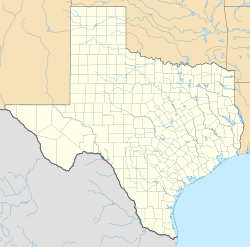Osage, Colorado County, Texas facts for kids
Quick facts for kids
Osage, Texas
|
|
|---|---|
| Country | United States |
| State | Texas |
| County | Colorado |
| Elevation | 325 ft (99 m) |
| Time zone | UTC-6 (Central (CST)) |
| • Summer (DST) | UTC-5 (CDT) |
| ZIP code |
78962
|
| Area code(s) | 979 |
| GNIS feature ID | 1343321 |
Osage is a ghost town located in the northwestern part of Colorado County in the state of Texas. A ghost town is a place where most people have left, and it's no longer a busy community.
This former settlement was situated on Harvey Creek. It was near the spot where County Roads 205 and 208 meet. This area is just a few miles northeast of the town of Weimar.
During the American Civil War, Osage was a large enough community to send a group of soldiers to fight. A well-known school also thrived in Osage starting in the 1870s. However, a new railroad was built through Weimar instead of Osage. By 1900, most of the businesses had moved to Weimar. This caused Osage to slowly disappear. In 2013, only a few people lived in the area.
Contents
Where Was Osage Located?
The Geographic Names Information System (GNIS) helps us find places. It shows that the Osage Cemetery is located at coordinates 29°44′28″N 96°42′54″W / 29.74111°N 96.71500°W. This spot is close to the intersection of County Roads 205 and 208 in Colorado County.
This location is about 6.2 miles (10 km) northeast of the center of Weimar. You can get there by following FM 155 and several county roads. The Colorado River flows a few miles to the north and east of the old town site. Other important spots nearby are the Old Osage Cemetery and the Adkins Cemetery.
The Story of Osage
Early Settlers Arrive
The first Anglo-American settlers in the Osage area were Tom Hubbard and his family. They moved from Mississippi in 1851. They started farming along Harvey Creek. This creek was part of a large piece of land given to Henry Austin, who was a cousin of Stephen F. Austin.
In 1855, a big group of Scotch-Irish and English immigrants arrived. They came from Laurel, Mississippi in a caravan of 36 wagons. After building their homes and harvesting their first crops the next year, their leader, Dr. Samuel D. McLeary, named the community Osage. He chose this name because of the Osage Orange trees found in the area.
Osage During the Civil War
In the early part of the American Civil War, Osage and other nearby communities helped form Company A of the 5th Texas Cavalry Regiment. This group of men went off to fight in the war. By 1862, Osage was a busy little town. It had a blacksmith shop, a cotton gin, many well-built homes, several stores, and a post office for the Confederate States of America.
The Famous School and the Railroad's Impact
E. B. Carruth opened a school in Osage in 1874. This school quickly became very famous in the area. Students came from as far as 100 miles away to attend. They would stay with local families while they studied.
However, a big change was happening nearby. The Galveston, Harrisburg and San Antonio Railroad was being built west from Columbus. In 1873, the new town of Weimar was established right along this railroad line. This was a problem for Osage.
Between 1873 and 1900, every single business in Osage moved. They packed up and relocated about 4 miles (6.4 km) southwest to Weimar. Weimar was now the center of activity because of the railroad. As a result, Osage slowly faded away. By the 1980s, only a few scattered farms and ranches remained in the area. This is why Osage is now known as a ghost town.


